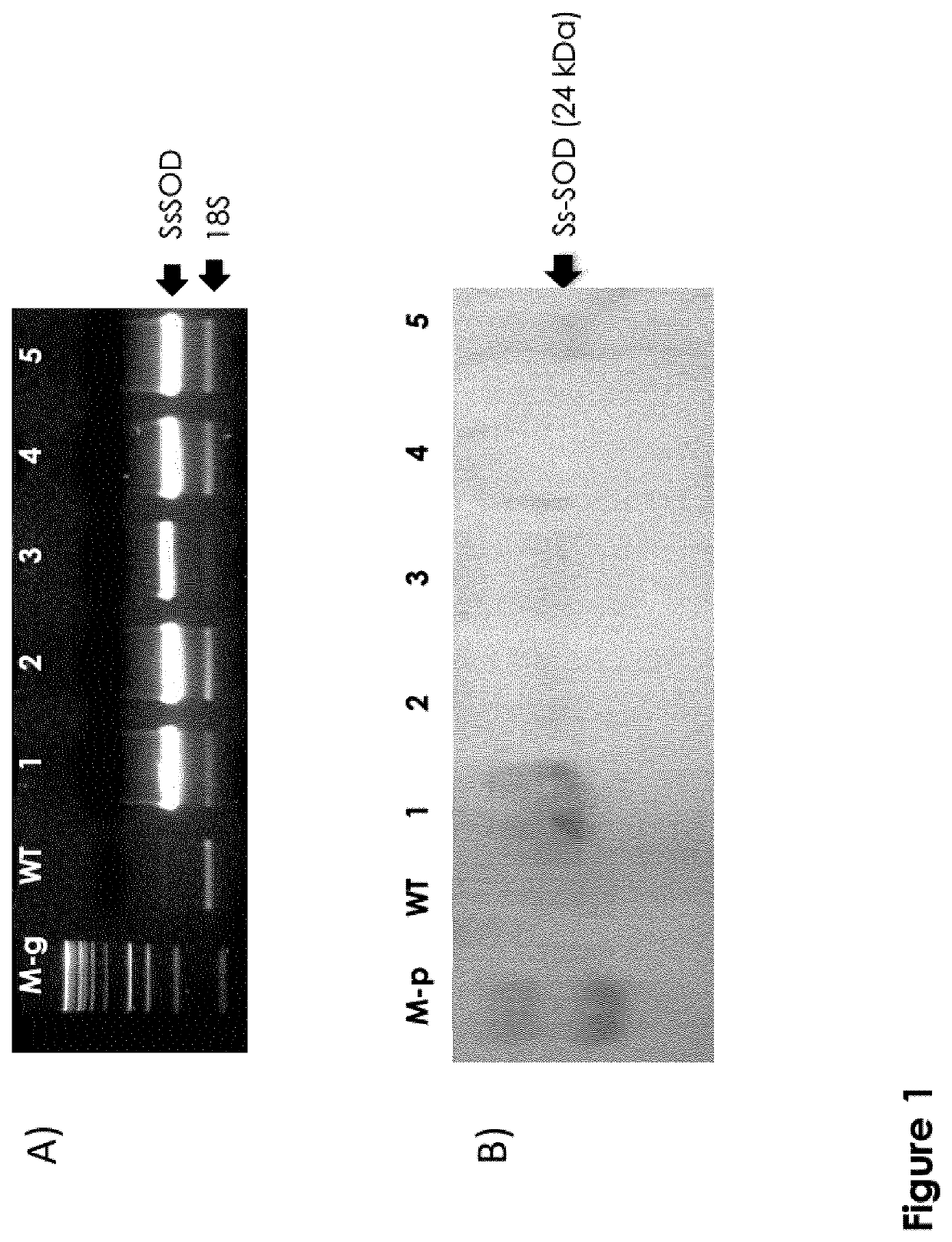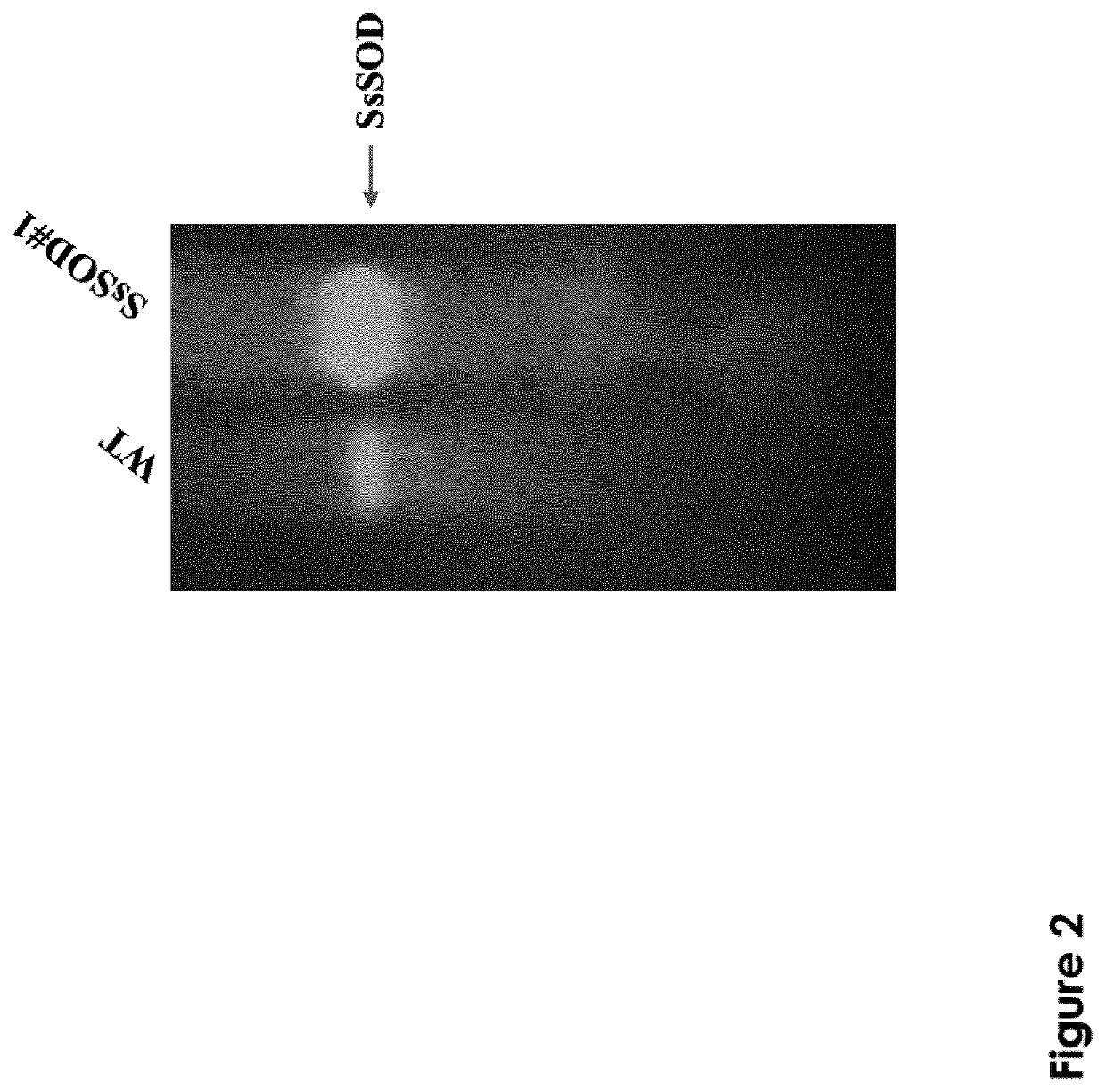Industrial applications of plant cell extracts comprising sod enzymes of extremophilic micro-organisms
a technology of plant cell extract and extremophilic microorganisms, which is applied in the field of industrial use of extracts, can solve the problems of food poisoning, rapid deterioration of the appearance, taste and nutritional value of the product, and food poisoning, and achieves the effects of compromising the health of consumers and affecting the health of consumers
- Summary
- Abstract
- Description
- Claims
- Application Information
AI Technical Summary
Benefits of technology
Problems solved by technology
Method used
Image
Examples
example 1
[0095]Expression in tomato cell cultures of the superoxide dismutase (SOD) belonging to the microorganism Sulfolobus solfataricus and characterization of the cell-derived extract.
[0096]For the expression in tomato cells (MicroTom variety) of the gene encoding for superoxide dismutase (SOD) of the extremophilic microorganism Sulfolobus solfataricus (SsSOD) (SEQ ID NO 1), the binary vector pBI121 engineered with the aforementioned gene was transferred into cells of Agrobacterium tumefaciens (LBA4404 trunk) for the genetic transformation of tomato cotyledons (S. lycopersicum).
[0097]The infected plant tissues were then transferred onto a specific culture medium for the induction of calluses, said medium containing the antibiotic kanamycin for selecting transformed cells. After about 6 weeks from the genetic transformation, a large number of calluses were regenerated, isolated from the remaining plant tissue, transferred onto fresh medium and analyzed by semi-quantitative RT-PCR. FIG. 1A...
example 2
[0155]Expression in Plant Cell Cultures of SOD Belonging to the Micro-Organism Aeropyrum pernix and Characterization of the Cell-Derived Extract.
[0156]The genetic transformation of tomato with Aeropyrum pernix SOD (ApSOD) (SEQ ID NO 2) was performed as described in Example 1, using Agrobacterium tumefanciens. Four transformed lines were analyzed by RT-PCR using specific primers for the ApSOD and comparing the amplification products with the amplified 18S ribosomal RNA obtained in the same reaction (multiplex PCR) (FIG. 4A). All the analyzed clones showed a high level of expression of the SOD while, as expected, no amplification band was found in the unprocessed tomato cells (wild type, WT) used as control.
[0157]From the Western Blot analysis, it was shown that the transgenic lines contained detectable amounts of the ApSOD protein, while in the untransformed line a slight hybridization band was barely visible due to the high similarity between the endogenous tomato SODs and the extre...
example 3
[0178]Expression in Plant Cell Cultures of SOD Belonging to Deinococcus radiodurans Microorganism and Characterization of the Cell-Derived Extract.
[0179]Deinococcus radiodurans SOD (DrSOD) (SEQ ID NO 3) was stably transferred to tomato via Agrobacterium tumefaciens.
[0180]The calluses selected on selective medium were analyzed by RT-PCR using specific primers for the SOD transferred sequence. FIG. 7A shows the RT-PCR of 5 transgenic lines. The amplification products obtained using specific oligonucleotides for DrSOD sequence were normalized to the amplified 18S ribosomal RNA obtained in the same reaction (multiplex PCR). All the analyzed clones showed a high level of SOD expression. The lines were then analyzed in Western-blot and, as shown in FIG. 7B, the transgenic tomato lines expressed DrSOD at high levels, whereas in the WT cell extract a slight band corresponding to an endogenous SOD is present.
[0181]The extract of line 3 containing DrSOD was used for the characterization of a...
PUM
| Property | Measurement | Unit |
|---|---|---|
| temperature | aaaaa | aaaaa |
| temperature | aaaaa | aaaaa |
| temperature | aaaaa | aaaaa |
Abstract
Description
Claims
Application Information
 Login to view more
Login to view more - R&D Engineer
- R&D Manager
- IP Professional
- Industry Leading Data Capabilities
- Powerful AI technology
- Patent DNA Extraction
Browse by: Latest US Patents, China's latest patents, Technical Efficacy Thesaurus, Application Domain, Technology Topic.
© 2024 PatSnap. All rights reserved.Legal|Privacy policy|Modern Slavery Act Transparency Statement|Sitemap



